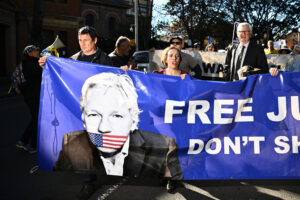Ending Nazi Symbols: Let’s Get It Right
Australia needs legislation outlawing the public display of Nazi symbols in the service of white supremacist ideology, but it is critical that we get the free speech balance right.
In the context of legislation recently passed by a number of Australian states, the federal opposition is seeking to outlaw the public display of Nazi symbols at a federal level. Two Bills sit before the parliament, the Criminal Code Amendment (Prohibition of Nazi Symbols) Bill 2023 introduced in the upper house by Senator Michaelia Cash in March, and another, with identical wording, introduced this week in the lower house by the former shadow attorney-general, Julian Leeser.
Senator Cash’s Bill was rejected by senate committee late last week, which may have informed Mr Leeser’s strategy in bringing the Bill before the house. However, it is interesting to see that Mr Leeser’s Bill has not adopted any of the well-considered recommendations stated in the committee report.
Nevertheless, the sustained interest in passing the Bill continues to place hate speech and censorship at centre of national debate. As a PhD candidate and now, researcher, I have spent the best part of the last five years immersed in research on the intersection of hate speech and free speech and for me, this Bill raises two important questions.
The first question is relatively uncontroversial: is removing the ability of neo-Nazis to display Nazi symbols on our streets a good thing? The answer should be a resounding ‘yes’. Nazism has no place in a democratic, multicultural Australian society. No one in Australia should have to live in fear because of who they are.
The second question is not so straightforward: how do we get the balance right to ensure that only those displaying Nazi symbols in bad faith are committing an offence? This one is tricky because, despite what I have just said above, there are many ways of displaying a Nazi symbol that we should want to protect. Examples that come to mind include using it to educate people about the rise of Nazism and the Holocaust, or in the production of a movie set in 1944 Berlin.
We must also consider their use in anti-fascist protest – photoshopping a Nazi armband onto a picture of a politician may appear in poor taste to some, but this sort of political action should not be conflated with pro-white supremacist political action and should certainly not warrant a prison sentence. These types of public presentations are important to maintain as lawful displays and must be protected from government overreach.
The Bill goes some way to meeting this threshold. The proposed legislation excludes anyone able to provide a ‘reasonable excuse’ (such as ‘genuine scientific, educational, or artistic purpose’) from the Bill’s proposed penalty of up to twelve months imprisonment or up to $27,500 in fines.
However, I don’t think this is enough when we look at the comparable legislation at the state level. The wording in the federal Bill is too vague and leaves the courts with too much discretion to interpret the legislation. In contrast, the Victorian Summary Offences Amendment (Nazi Symbol Prohibition) Act passed in 2022 provides actual examples within the legislation itself (see Section 41K [2][B] and [D]) of various contexts that are exempt from prosecution.
It is also questionable whether the federal Bill gets the specific wording it does use right. For example, exception is made in the legislation for “a person’s work as a journalist in a professional capacity” – yet what of those who would report on the issue without the professional credentials? Compare this to similar proposed Queensland legislation which instead explicitly protects “publication of a fair and accurate report of an event or matter of public interest”, regardless of who the publisher is.
The Queensland Government’s Criminal Code (Serious Vilification and Hate Crimes) and Other Legislation Amendment Bill also does a better job than the federal legislation at delineating the distinction between private and public spaces. This area is a key concern of critics, who want to ensure that people have the right to do what they want within the confines of their own home. Having more detailed language around what constitutes a public space is essential to ensuring that no misinterpretation or wilful overreach can occur in the future.
When it comes to free speech, getting the balance right is not always easy. No one wants to see speech limited any more than it needs to be, yet it is clear that there should be no protection of freedoms for those who would deny those same freedoms to others.
Tackling white supremacy is something Australia can no longer shy away from. Let’s make sure we get the legislation right to ensure that Australia remains not only free and open, but also a safe country for all who live here.
Related research
Between the Lines Newsletter
The biggest stories and the best analysis from the team at the Australia Institute, delivered to your inbox every fortnight.
You might also like
Stage 3 Better – Revenue Summit 2023
Presented to the Australia Institute’s Revenue Summit 2023, Greg Jericho’s address, “Stage 3 Better” outlines an exciting opportunity for the government to gain electoral ground and deliver better, fairer tax cuts for more Australians.
McCarthy’s fall and the far-right influence on American foreign policy
Critical support for Ukraine’s war effort could be torpedoed by a small minority of US congressional extremists.
The Cruelty Is The Point: Australia and the Politics of Empire
Watch Dr Emma Shortis’ address to ‘Night Falls In The Evening Lands: The Assange Epic’ at RMIT University, Melbourne, on 9th March 2024.


